Oct 5th 2019 - J. Vigotsky
What is Hibachi? – Good Times and Great Food
Hibachi is an art that is likely already second nature to anyone who enjoys cooking or who has eaten Asian cuisine. But what exactly is hibachi, and how did it come to be featured at seemingly all Japanese eateries? This article will introduce you to the basics of hibachi cooking.
What is Hibachi? (Japan's open-fire grill)
Hibachi-style cuisine is prepared in front of the diners on a huge table that has a built-in grill. The chef's antics, which typically include tossing food into the air and performing other feats, make for an entertaining and memorable dining experience.
In Japanese culture, hibachis are containers that are made of heatproof material and hold burning charcoal. Surprisingly, they traditionally aren’t used for cooking. But in the United States, hibachi is associated with drop-in Teppanyaki griddles that are commonly integrated into dining tables. Many diners gather around the table to watch a master chef not only cook on these griddles but also perform. Popular throughout the country, Hibachi-style restaurants offer unique, interactive dining experiences. The following are just a few reasons why Hibachi restaurants are so popular:
Meat, seafood, and even vegetables (such as onions, zucchini, and mushrooms) can be cooked to perfection over high heat on a hibachi, a classic Japanese-style grill. Hibachi grills typically feature a flat, open top and are made of metal.
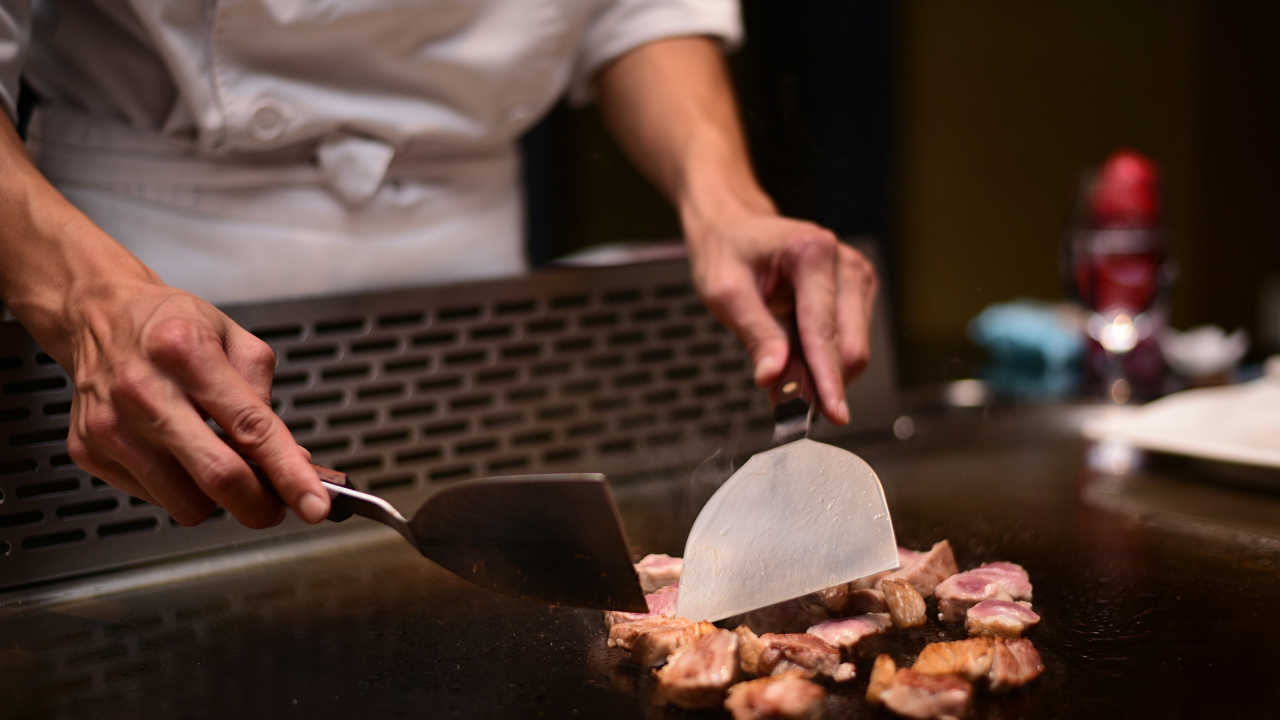
The term "hibachi" can also refer to the method of cooking employed by these grills, which entails searing and then quickly re-heating small portions of food to seal in its natural juices and tastes. It is important to note that the term "Hibachi" can be used to describe both the cooking equipment and the technique. Hibachi is also great for making fried rice.
Hibachi grills can be fueled by charcoal or gas, and in addition to being a popular method of cooking, they are frequently depicted in works of Japanese literature, art, and film as a cultural icon of hospitality, warmth, and friendliness. Hibachi scenes are common in Japanese animation and cinema.
History of Hibachi

As far back as the Heian period (794 to 1185), the term "hibachi" referred to a portable heating device used in Japan. This is used to heat a space or offer warmth while engaging in outdoor activities. However, it also became a popular cooking tool in the early 1900s. The hibachi was essentially a little barbecue and was used to grill small foods like fish.
However, hibachi, as we know it today, didn't take off until the 1960s. Hibachi-style cooking is now available at Japanese restaurants throughout the United States. Hibachi is now a standard menu item at most Japanese restaurants overseas. While all chefs use the same basic techniques, the appealing dishes they create are uniquely their own.
Types of Hibachi
Hibachi Charcoal Grills
A portable hibachi charcoal grill is the answer to your grilling problems if you want the flavor of charcoal-grilled food but don't have room for a full-sized grill on your patio or if you like to grill when traveling.
Small, light, portable, and cheap, hibachi charcoal grills are ideal for camping and tailgating.
They're great for camping and tailgating or if you have a modest living space.
Because of how near the meal is to the flame or heat, it absorbs the smokey flavor and gains depth. They are also a quick and easy way to prepare meals.
Cooked on Flat-Top Grills or Gas Griddles
- A gas griddle or flat-top grill would be a great addition to your outdoor kitchen.
- They're great because you can put your cookware right on the sizzling iron griddle.
- For even cooking, the heat source is distributed evenly throughout the surface.
- Since grease is diverted away from the burner, flare-ups are avoided.
- They have several models to choose from: they can be wall-mounted or stand-alone.
- They're a fun way to get the whole family involved in the preparation and sharing of a meal.
Teppanyaki Gas Grills
The entertaining nature of teppanyaki grilling is one of its most eye-catching features.
They are identical to conventional flat-top grills and gas griddles except that they are freestanding. You can impress y diners or loved ones with your culinary skills with these.
Steak, fish, chicken, and vegetables can all be cooked simultaneously on various cooking surfaces. The natural flavors of the foods are enhanced by cooking them in their own juices.
What makes Hibachi so good and Why is it so popular
Quick cooking time on the grill helps seal in flavor and creates a distinctive flavor that is difficult to achieve with other cooking methods. This is why most meats and veggies grilled on a hibachi tend to be so tasty and delicate. The health benefits of hibachi cooking are as follows:
Fun and Entertaining
The atmosphere is what makes hibachi so enjoyable. Hibachi is more than just lunch because of the delicious Japanese food and lively setting. It's a fun and different way to eat with loved ones that will be spoken about for years to come.
Perfect for Get-togethers
Want to strengthen the bonds between you and your loved ones, friends, and even coworkers? A fantastic chance awaits you at a hibachi restaurant. The natural setting for such a meal is around a large, communal grill, where diners may chat and catch up with one another. This creates a fantastic possibility for gatherings and celebrations of many kinds.
Lets You Experience Unique Spice
To enhance the flavor of their dishes, many hibachi cooks turn to an array of sauces and spices. These Asian foods can benefit from a wide range of ingredients, including but not limited to soy sauce, garlic, ginger, and teriyaki. The grill's intense heat also imparts an unrivaled flavor that can't be achieved with any other cooking method.
Dishes Can be Tailored According to Taste
Meats, fish, veggies, and even rice are all fair game for hibachi preparation. You get to create your own dish by selecting the ingredients and seasonings you choose.
Unique Chef-Guest Interaction
When you dine hibachi-style, you get to watch your cuisine being made and chat with the chef, making for a unique and memorable dining experience.
The Fundamentals of Hibachi
Community
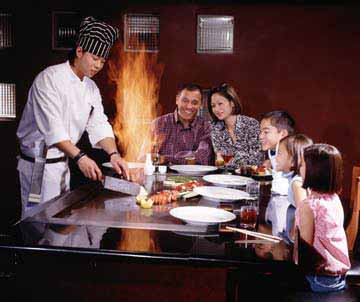
A hibachi restaurant table fosters community like few dining experiences can. You’ll sit down with a large group that consists of either friends, family, or total strangers. Diners share meals, toast drinks, and excitedly cheer on the master chef who performs right in front of them. Great for meeting new people or catching up with old friends, this type of atmosphere ideal for a social night out at a restaurant.
Fire
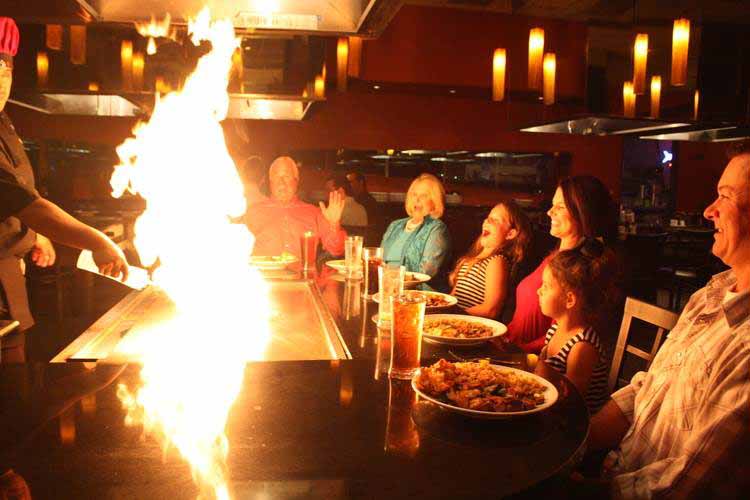
The cooking of each hibachi meal starts the same way: a chef uses a squeeze bottle to cover the griddle with oil then ignites it all in one glorious inferno. Diners “Ooh” and “Ahh” at the flame that signals the beginning of their meal experience. Once the fire dies down, a chef does what he does best: cook with the dramatic flair of a Broadway performer.
Theater
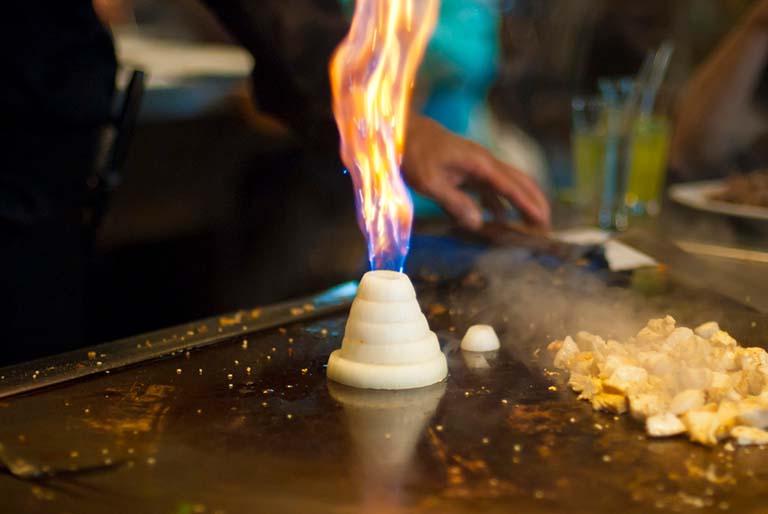
The master chefs who operate the Teppanyaki griddles at hibachi restaurants are more than just skilled chefs. Cooking with style, these chefs boast enough charisma to keep diners captivated by their theatrical performance. Whether they’re igniting fires, creating onion volcanoes, juggling turners, cracking jokes, or catching food atop their chef hats, hibachi chefs are showmen who know that providing delicious food is only half their job. If you like attempting to catch food or sake in your mouth—or watching other people attempt to catch food or sake in their mouths—the opportunity will surely arise at a hibachi restaurant.
Sake
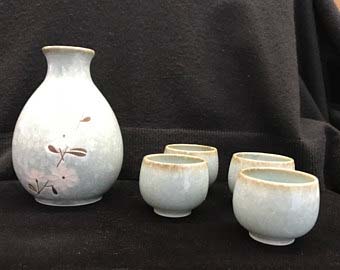
Where there’s hibachi, there’s almost always sake. Also known as Japanese rice wine, sake is the national beverage of Japan and more similar to beer than wine in how it’s prepared. The beverage usually comes in authentic sake cups and bottles that are white, ceramic, and have a distinctly Eastern style. Sake can be served chilled, heated, or at room temperature. The proper serving temperature usually depends on the exact type of sake being consumed.
Culture and Décor
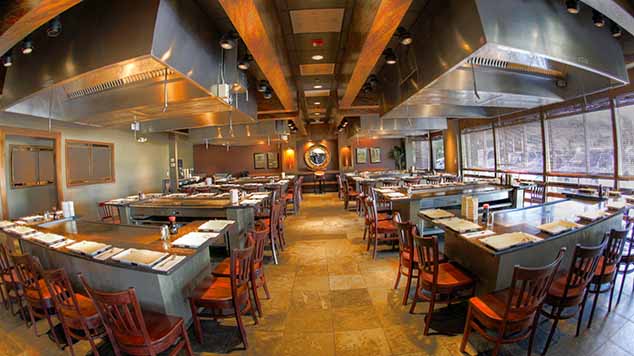
Hibachi restaurants are usually steeped in traditional Japanese culture. Minimalistic architecture is accompanied by traditional ornaments and color schemes. Delicate lighting enables patrons to focus entirely on their meal, their fellow diners, and the experience. Hot towels that have been warmed via towel steamers can be found at many of these establishments. Some meals also come with Chinese soup spoons and sauce dishes that include several distinct sauces. Whether you prefer soy sauce, duck sauce, or hot and spicy sauce, there will be something that satisfies your particular taste.
Educational
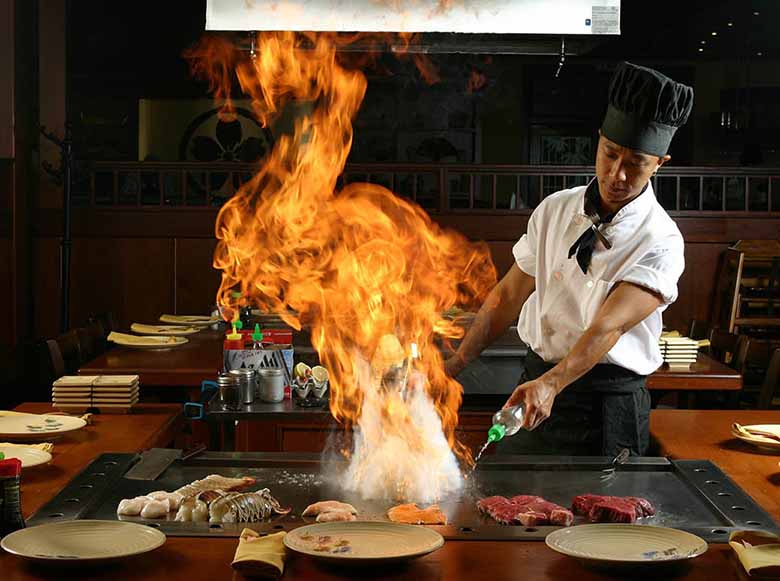
Watching a professional chef work his magic right in front of you helps demystify the cooking process a little bit. While you might not quite be able to put on the same type of show as these highly skilled chefs, you can surely pick up a tip or two that’ll help you cook in your own kitchen. Even if you’re too busy chatting with friends or drinking sake to pick up on any game-changing skills, you’ll at least be able to see with your own two eyes that there’s nothing overly complicated about cooking hibachi-type dishes.
Delicious Meals
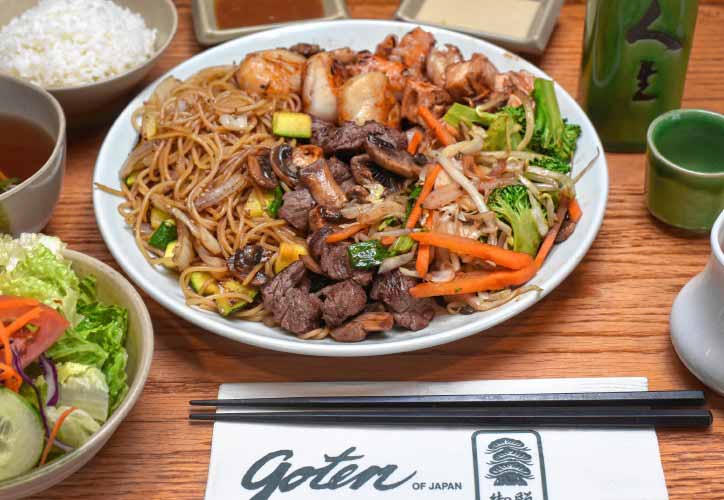
Hibachi meals usually start with either white or fried rice. Rather than watch the rice warm in a commercial rice cooker, you’ll get to see the chef cook rice right on the Teppanyaki griddle. Next up are noodles and some type of protein-dense dish: chicken, pork, beef, and fish are all common choices. Finally, a serving of vegetables adds some nutritional punch to the meal.
There are plenty of reasons to eat at any hibachi restaurant. If you’re looking for a delicious meal and a fun time out with friends, you can’t go wrong by opting for hibachi.
How is Hibachi Cooked?
The high heat and rapid cooking method used in hibachi cooking is what gives the meal its signature tenderness and robust taste. If you want to give hibachi a try in your own kitchen, there are a few things you'll need. You'll need a hibachi grill to begin, and you can find such in stores and on the web in a variety of sizes and designs.
What Can You Cook On Hibachi?
Hibachi grills are versatile enough to prepare any meal, from meat and fish to rice and veggies. The most popular dishes to cook on a Hibachi grill are chicken, steak, and shrimp.
Best Hibachi Dishes You Need To Serve
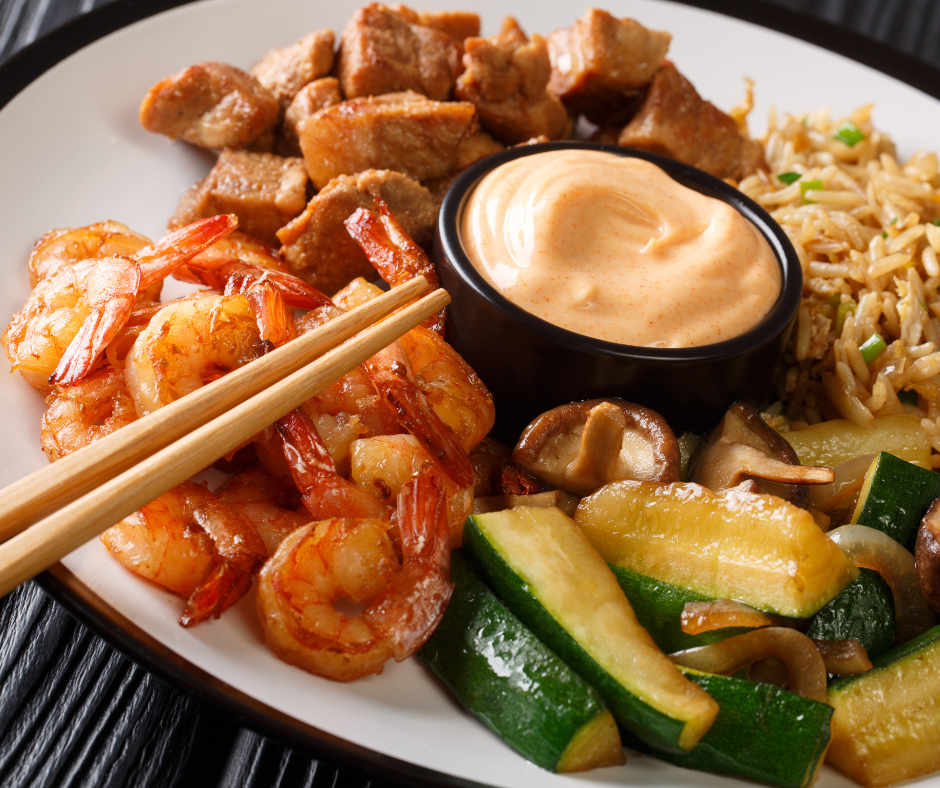
- Hibachi Mustard Sauce: Yellow mustard, vinegar, and sugar are the main ingredients of hibachi mustard sauce and you may use this sauce to dip grilled meats and vegetables in. The acidity of the vinegar cuts through the fattiness of the pork, while the sweetness of the sugar balances it out. The hot kick from the mustard goes well with the other flavors.
- Hibachi Vegetables: Vegetables prepared in the Hibachi manner are commonly offered as a vegetable dish. Mushrooms, onions, and peppers are commonly used in their preparation. They are grilled or stir-fried over a sizzling griddle. Before being cooked, the veggies are typically seasoned with salt, pepper, and soy sauce and this makes them taste flavorful, perfect for accompanying grilled meats or shellfish.
- Hibachi Chicken: The secret to perfect Hibachi chicken is a marinade of soy sauce, honey, and rice wine vinegar. Grilling or stir-frying the chicken is the next step. The smokiness of the grill complements the sweet and savory notes. This is attributed to the soy sauce, honey, and rice wine vinegar. Common side dishes include steamed rice and greens.
- Hibachi Fried Rice: Hibachi fried rice is a type of fried rice that is stir-fried with a variety of ingredients. Soy sauce, sesame oil, and garlic are common additions to the rice. It's a fantastic method to recycle any extra meat or vegetables in the fridge. It's a simple supper that can be prepared in less than 30 minutes.
- Hibachi Noodles: Hibachi noodles are a type of Japanese noodle commonly served with Hibachi-style food and it is made with just wheat flour, water, and salt. These noodles are commonly grilled and stir-fried with a variety of toppings. Soy sauce, sesame oil, and garlic are common condiments used to season the noodles and you may use any meat and vegetables you have on hand to make these noodles. They may be prepared in less than 30 minutes, making them a convenient weeknight meal option.
- Hibachi Ginger Salad Dressing: The salad dressing known as Hibachi Ginger Salad is a sweet and tangy sauce typically served on salads at Japanese steakhouses. This vegan dressing is simple to create, requires few ingredients, and is superior to bottled varieties. If you create the dressing at home with high-quality ingredients, you may avoid using any artificial flavors or preservatives.
- Hibachi Salmon: Hibachi Salmon is a popular dish at Japanese steakhouses. They are made by coating salmon steaks with a sauce made from soy sauce, cooking wine, garlic, lemon juice, and ginger, and then pan-frying them. The recipe is quick and simple to prepare, making it ideal for busy weeknights. Yum-yum sauce, rice, and Hibachi vegetables are common accompaniments.
Hibachi vs Teppanyaki
Teppanyaki is a Japanese grilling technique that uses a flat iron plate. Hibachi and teppanyaki are two distinct but related Japanese cooking techniques. Here are some key distinctions between the two.
Menu
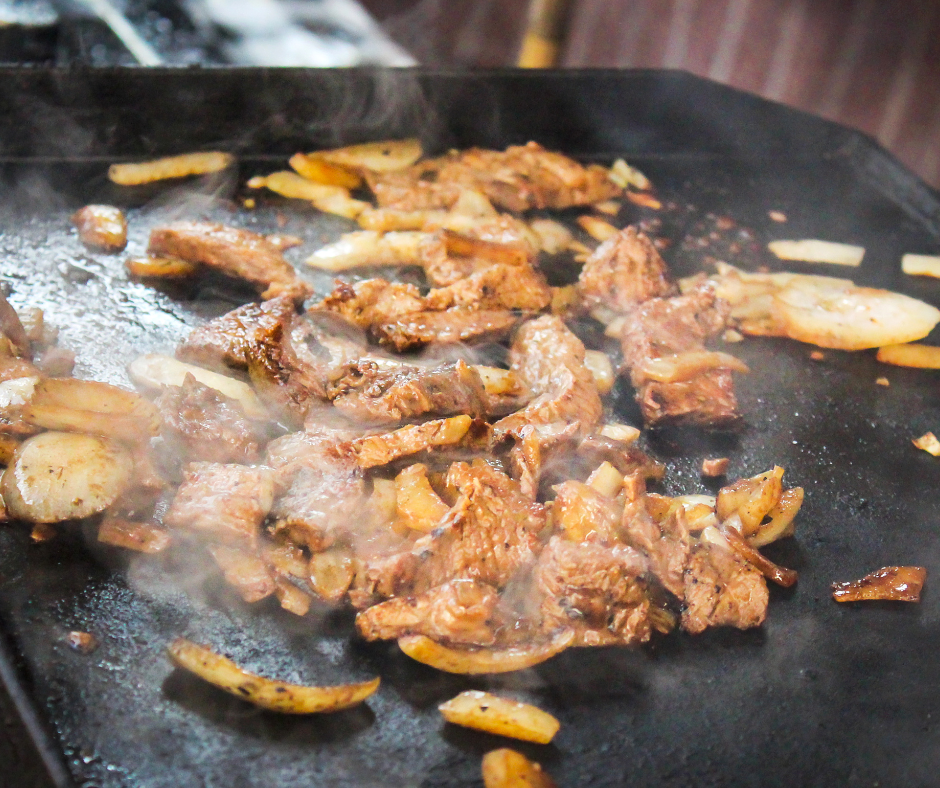
While both hibachi and teppanyaki make use of various meats, fish, veggies, and rice, the selection of hibachi dishes is typically more limited than that of teppanyaki. In contrast to teppanyaki, where customers are typically allowed to choose from a greater selection of items, hibachi typically offers a set menu consisting of a few pre-selected options.
Equipment
Hibachi grills differ from standard barbecues in that they are griddled, compact, and fuelled by either charcoal or gas. As with the meat, the dish is cooked over an open flame. In contrast, teppanyaki grills are built-in, massive, flat griddle surfaces heated by gas or electricity. Teppanyaki can be used to prepare a wide variety of foods.
Set-up
Hibachi-style dining typically involves sitting around a communal grill with other diners, which may lead to a lively and engaging ambiance. The private and cozy atmosphere of a teppanyaki dinner can be enhanced by the arrangement of individual tables around a central grill.
How Healthy is Hibachi?
Hibachi is a healthy cooking method since it does not overheat food and destroys its nutritional value. Meat eaters and vegetarians both won't be disappointed with this dish. Sake, soy sauce, miso paste, and mirin (sweet rice wine) are all staples in hibachi cuisine, and they're all good for you. These components are used to make a flavorful marinade and sauce. These are then brushed or drizzled over the food as it cooks.
Overall, both hibachi and teppanyaki are fantastic Japanese cooking methods that provide a delicious and exciting meal. Hibachi-style cooking, on the other hand, provides a one-of-a-kind and unforgettable dining experience with a wide variety of advantages, such as freshness, entertainment, spices, healthiness, customization, and comfort. Many people really like it because of the way the fresh ingredients, tasty sauces, and participatory cooking all come together.

